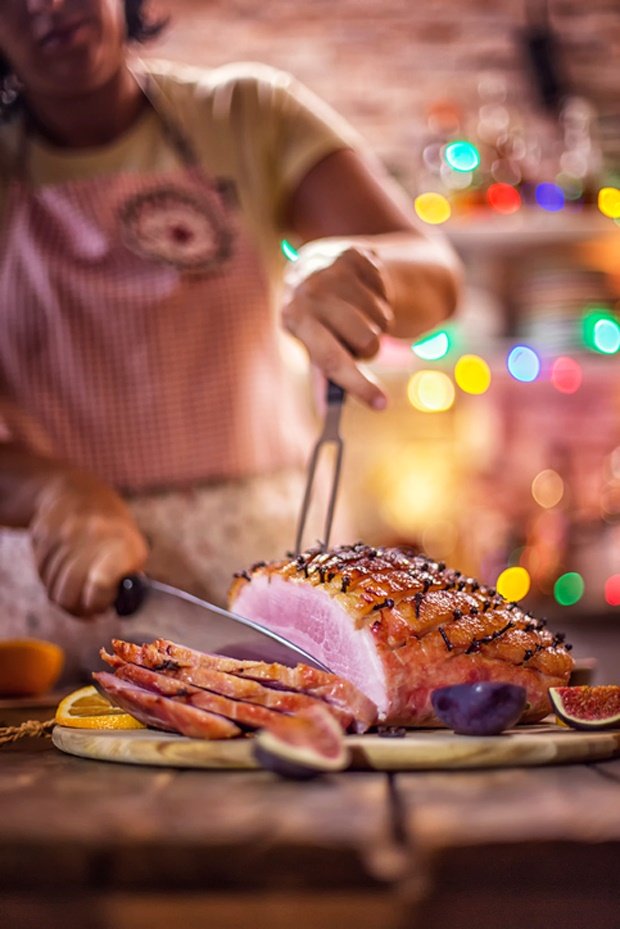Gammon ‘‘gam?n’’ (Noun BRITISH): Ham which has been cured or smoked like bacon.
Finding the perfect gammon
Gammon is readily available in supermarkets and from specialist butcheries around this time of year. Free range is always great for your palate and conscience (although perhaps not your wallet) if you can find it. Select a size that will feed all your guests (with a few leftovers for sandwiches on Boxing day) and choose from the bone in or bone out.
Curing and smoking
The process of curing and smoking preserves the gammon. Curing may be dry or wet (either coated in salt and left to hang or soaked in a salt solution). Dry cured will give you a lot more flavour as a lot of the water will have evaporated. Smoking gives the gammon its distinctive flavour and can be done with a variety of woods to introduce more flavour.
Bone-in or bone-out?
Bone-in gammon will take longer to cook and is more difficult to carve, but works out a little cheaper per kg usually. Bone-out gammons have been cut off the bone and rolled (usually tied with string or netting) and can be carved like a loaf.
What size?
Bargain on about 200g per person of protein for a main meal. If you are also serving turkey or any other roast then you don’t need as much and if you are factoring in children they will eat less per person. The bottom line? An average 1.7kg roast (bone-out) would serve 8-10 people. Bone-in a 1.7kg roast would feed about 6-8 people.
Freezing
Gammon can be successfully frozen for 3-6 months. The curing process means that it also keeps very well in the fridge, so you don’t need to freeze your gammon if you purchase it in the 2-3 weeks before Christmas. It does mean that if you pick up a cheap gammon on sale AFTER Christmas you can keep it for your Christmas in July!
Soaking
The first step to gammon nirvana is soaking your gammon overnight. Place it in a large bowl or bucket and cover with fresh water. If you have a frozen gammon, you can allow it to defrost in the water. Discard the water in the morning; soaking removes excess salt.
Boiling vs roasting
There are two main ways to cook a gammon, boiling or roasting. Boiling requires a large pot, but if you are making another roast for Christmas dinner and oven space is limited then boiling is a great option. Place the gammon in a large pot, cover with fresh water, add a carrot, an onion, 10 peppercorns, a bay leaf and a couple of cloves. Simmer for 20 minutes per 450g plus an additional 20 minutes. Keep the water topped up if necessary. Leave to cool in the water.
Roasting can also be done in the oven or on the fire. Place the gammon in a large roasting tray and cover with foil. Roast at 180°C for 30 minutes per 450g plus an additional 30 minutes. 30 minutes before the end of the cooking time remove the foil. Follow the instructions for the glaze for the last 30 minutes of cooking.
A hybrid method can also be used. If you don’t have a pot large enough to boil the joint, place it in a roasting pan, fill the pan with water and cover with foil. Bake in the oven as per the roasting instructions and leave to cool in the water.
Testing for done-ness
Test that the gammon is cooked by inserting a knife and checking to see if the meat is tender. If it still has a “springy” feel cook for a further 15 minutes and test again.
Glazing
By far the most important step! Once your boiled gammon is cooked and slightly cooled or at the last 30 minutes of roasting. Remove the skin from the outside of the gammon and discard.Cut away any excess fat leaving about a 1cm covering of fat all over the roast. Score this lightly with a knife to make a diamond pattern. This will help the glaze to adhere so don’t skip this step.
If you want to go old school, stud each corner of the diamonds with a clove. Brush on the glaze all over the fat and place under the grill for about 5 minutes or if you are roasting return to the oven for the last 30 minutes. Every few minutes brush on more glaze. The glaze should be bubbling and golden (do not let it blacken). Leave to rest for a few minutes before serving.
Easy gammon glaze recipe:
½ cup smooth apricot jam
½ cup treacle sugar
1 Tbsp hot English mustard powder
Mix well together and brush liberally over gammon to glaze.
ALSO READ…
3 Insane gammon recipes that will make you rethink your Christmas menu
Some say that gammon was first eaten at Christmas time by the Germanic people as a tribute to their God and was often associated with harvest and fertility. In Nordic countries the Christmas ham is coated with a layer of mustard, egg and breadcrumbs.

